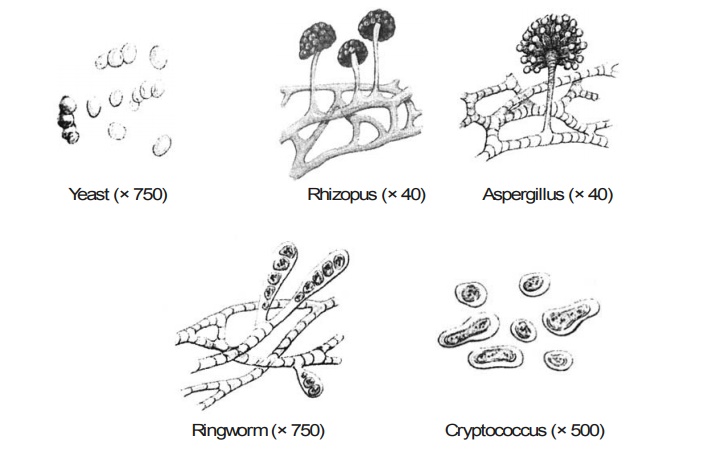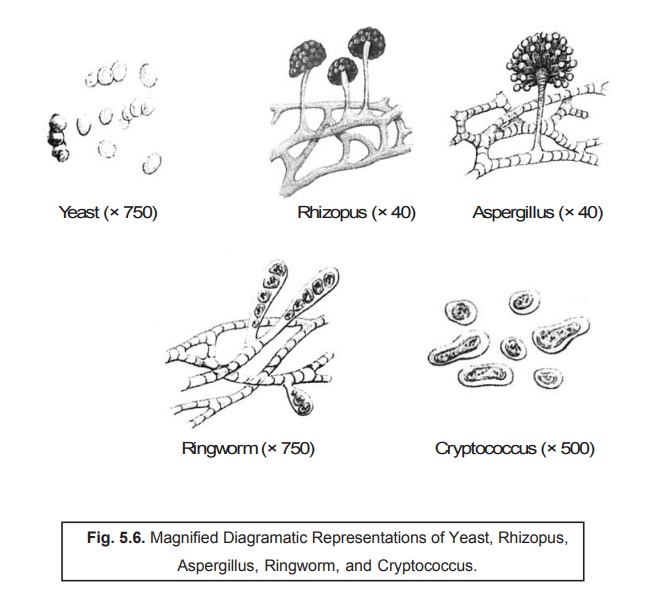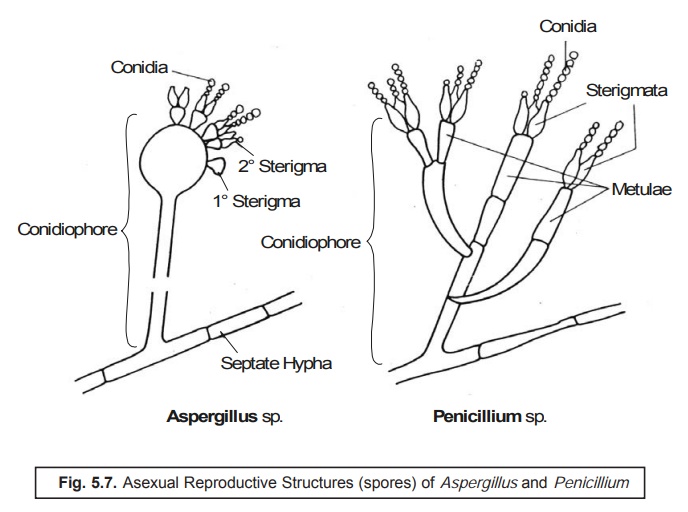Nutrition, Cultivation, Reproduction and Isolation of Fungi
| Home | | Pharmaceutical Microbiology | | Pharmaceutical Microbiology |Chapter: Pharmaceutical Microbiology : Nutrition, Cultivation and Isolation of microorganisms : Bacteria-Actinomycetes-Fungi-Viruses
The kingdom of organisms that essentially includes yeast, molds, and mushrooms, is termed as fungi.

FUNGI
The
kingdom of organisms that essentially includes yeast, molds, and mushrooms, is termed as fungi.
It has
been duly observed and amply demonstrated that fungi invariably grow as single
cells, as in yeast, or as multicellular filamentous colonies, as
in molds and mushrooms. Interestingly, fungi
do not contain chlorophyll (i.e., the nature’s organic green
matter), hence they are saprophytic
(i.e., they obtian food from dead
organic matter) or parasitic (i.e., they obtain nourishment from the
living organ-isms), and above all the body’s normal flora categorically
contains several fungi. However,
most fungi are not pathogenic in nature.
Importantly,
the fungi that essentially cause
disease belong to a specific group known as fungi imperfecti. In
immunocompetent humans these fungi usually cause minor infections of the hair, nails, mucous membranes,
or skin. It is, however, pertinent
to mention here that in a person having a
com-promised immune system due to AIDS or immunosuppressive drug therapy, fungi critically serve as
a source of the viable opportunistic
infections that may even cause death ultimately.
Figure
5.6, illustrates the magnified diagramatic representations of yeast, rhizopus, aspergillus, ringworm, and cryptococcus.

Another
school of thought defines fungi as — ‘those microorganisms that are invariably
nucleated, spore-bearing and do not
possess chlorophyll, generally reproduce both asexually and sexually, and have
somatic structural features that are essentially surrounded by cell walls
com-prising of polysaccharides, cellulose and/or chitin, mannan, and glucan.
In fact, fungi are considered to be mostly saprophytic, making use of dead organic matter as a source of energy, vital natural organic decomposers, and destroyers of food stuffs. While a major segment of species happen to be facultative parasites that specifically able to feed upon either
live or dead organic matter, and a relatively minor quantum of species may only
survive on the living protoplasms. These fungi are designated
as obligate parasites thereby
overwhelmingly causing dis-ease of man, animals, and plants. They also prove to
be of reasonably great economic and medical importance.
Industrial Research — Certain
fungi are intimately associated with the manufacture of bread, beer, and wines (fermentative procedures) ; production
of edible varieties of cheese, vitamins, and organic acids (viz.,
lactic acid, citric acid, acetic acid etc.) ; and several ‘antibiotics’.
Biological Research — Geneticists and Biochemists exploit the
fungi profusely by virtue of their
extraordinarily unique reproductive
cycles, but having a rather relatively simple
metabolism.
Reproduction (Cultivation) of Fungi
A large
number of fungi invariably get
reproduced both asexually and sexually. Nevertheless, the ensuing morphology, and the cycle of these reproductive structures
is employed extensively in carrying out their elaborated and logical classification.
i. Asexual Reproduction
The most
common procedure of asexual reproduction
is usually accomplished by the help of spores.
In common practice most of them are found to be colourless (hyaline), while a few of them are duly pigmented as green, yellow, red,
orange, black or brown. In fact, their size may invariably range from small to
large and their shape from globose via oval, oblong, needle-shaped to
helical. Virtually, the ensuing infintie variation in adequate spore appearance
and their arrangement prove to be of im-mense utility for proper identification. Asexual reproduction may be borne
particularly in a sac-like structure termed as sporangium ; and the spores being referred to as sporangiospores being called as conidia as depicted in Fig. 5.7.

[Adapted
From : Hugo and Russell : Pharmaceutical
Microbiology, 3rd edn, 1984]
Salient Features : The salient features related to asexual reproduction are as follows :
(1) The
simplest form of available fungal spore is known as the zoospore, which possess no rigid cell wall, and is duly propelled
by flagella.
(2) Flagellum is usually found to be much more
complex than that observed in bacteria.
(3) Flagellum is made up of 11 parallel fibrils, of which
9 forming a cylinder and 2 placed
centrally.
(4) Base
of flagellum enters the cell and
gets attached to the nucleus by a structure termed as rhizoplast.
(5) Flagellum structure (9 + 2 fibrils) is
usually found to be fairly consistent with that shown for other flagellated
organisms.
(6) Sporangium designates the asexual reproductive structure pertaining
to these aquatic fungi. In its early
stages it is found to be loaded with
nuclei and protoplasm.
(7) Cleavage
takes place subsequently whereby the numerous sections invariably get developed
into the corresponding uninucleate
zoospores.
(8) Finally,
following a motile phase, the resulting zoospore encysts, losing its flagellum, and rests quietly just prior
to germination.
ii. Sexual Reproduction
Importantly,
the sexual reproduction is
characterized by the strategical union of two
compat-ible nuclei ; and the entire phenomenon may be distinctly divided
into three phases, namely :
Phase I : The union of the gametangia (i.e., sex-organs) brings
the nuclei into close proximity within
the same protoplast. It is also referred to as plasmogamy.
Phase II : It is known as karyogamy, which takes place with the
fusion of two nuclei. It has been duly
observed that in the lower fungi the
said two processes may take place in immediate
sequence ; whereas, in the higher
fungi they do occur at two altogether different time periods in the course
of their life-cycle.
Phase III : It is known as meiosis that essentially takes care of
the nuclear fusion whereby the actual number of the chromosomes is distinctly and
significantly reduced to its original
haploid state.
Related Topics

